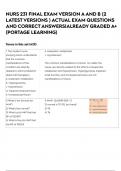NURS 231 FINAL EXAM VERSION A AND B (2
LATEST VERSIONS ) ACTUAL EXAM QUESTIONS
AND CORRECT ANSWERS|ALREADY GRADED A+
(PORTAGE LEARNING)
Terms in this set (429)
1. The student nurse a. Anaerobic metabolism
studying shock understands c. Hypotension
that the common
manifestations of this The common manifestations of shock, no matter the
condition are directly cause, are directly related to the effects of anaerobic
related to which problems? metabolism and hypotension. Hyperglycemia, impaired
(Select all that apply.) renal function, and increased perfusion are not
a. Anaerobic metabolism manifestations of shock.
b. Hyperglycemia
c. Hypotension
d. Impaired renal perfusion
e. Increased perfusion
1) What is the formula for 1) MAP= (2xDBP)+SBP / 3
MAP? 2) normal is 70-110, but trend!
2) What's the normal? 3) 93
3) What is pts MAP that has 4) 76
BP of 120/80?
4) What is the pts MAP that
has BP of 100/65
, Hemodialysis
-Hypotension: Monitor BP
-Dialysis disequilibrium syndrome: Monitor LOC
-Cardiac events: Equipt room with defibrillator incase of
arrest; Assess heart sounds for rub indicating pericardial
disease
-Reactions to dialyzers: Discontinue immediately without
returning blood; Hypotension can occur so monitor BP,
LOC, VS
actions that prevent and Peritoneal Dialysis
manage complications of -Peritonitis: Ensure sterile technique
hemo-and peritoneal -Pain: Slowly infuse; Warm solution prior (NOT in
dialysis. microwave)
-Exit site and tunnel Infection: Ensure sterile technique;
Ensure there is no pulling, kinking, tugging on catheter
-Poor dialysate flow: If prescribes, give enema prior to
PD; Ensure drainage bag is lower than the pts abdomen
Look for any kinking; If it's from a clot, milk the tubing to
move the clot
-Dialysate leakage: Monitor for clear drainage from exit
site; Know that new PD pts may not be able to tolerate
full 2L of drainage, and leakage will more than likely
occur
, Sodium Channel blocker: Lidocaine
-Adverse: Generally well tolerated; CNS: drowsiness,
confusion, parestheias; Toxic doses: seizures and resp.
arrest
-Care: Always have resuscitations equipment available;
Neurological checks; BP and ECG monitoring; Caution
with impaired liver;
Potassium Channel blocker: Amiodarone
-Adverse: Prolonged QT, AV blocks; Hypotension,
bradycardia; Proarrhythmic; Thyroid toxicity, cardiac
toxicity, liver toxicity, ophthalmic effects,
photosensitivity, pulmonary toxicity (long term)
-Care: Pulmonary function tests; Continuous ECG
monitoring; Monitor HR, BP; Very long half life; CTN in
pregnancy; Eye exams
Adenosine
-Adverse: Lasts only 1 minute; Sinus bradycardia,
dyspnea, hypotension, facial flushing, chest discomfort
Actions that promote safe -Care: Have emergency equipment readily available;
and effective drug therapy Extremely short half-life (1.5-10 seconds); Must be
for patients with administered by IV bolus as close to heart as possible,
dysrhythmias followed by quick saline flush
*all drugs used to treat Digoxin
dysrhythmias have -Adverse: bradycardia; Cardiotoxicity (dysrhythmias);
proarrhythmic effects, so all Risk is increased with hypokalemia; N/V, anorexia,
of these drugs can worsen fatigue, visual disturbances
existing dysrhythmias, and -Care: Monitor for S/S of toxicity; ECG; Monitor
create new ones potassium levels; Hold if HR <60 bpm
Beta/alpha adrenergic: Dopamine
-Adverse: Tachycardia, dysrhythmias, anginal pain
-Care: Ensure patient has adequate intravascular volume
before instituting (IV fluids)
, Beta/alpha adrenergic: Epinephrine
-Adverse: Increased HR, BP; Cardiac dysrhythmias
-Care: ECG monitoring; Vitals (HR, BP, etc.); First drug
given in pulseless arrhythmias
Beta-blocker/ potassium channel blocker: Sotalol
-Adverse: Torsades (serious dysrhythmia that increased
incidence with hypokalemia); Bradycardia, AV block, HF,
bronchospasm
-Care: Caution with other drugs prolonging QT; Must
check coagulation status before (NO clots)
K+ channel blocker: Ibutilide
-Adverse: Tors




